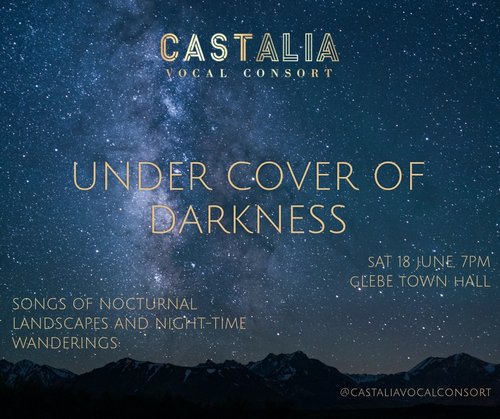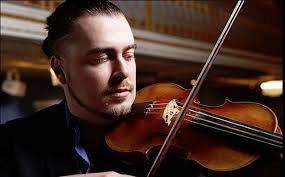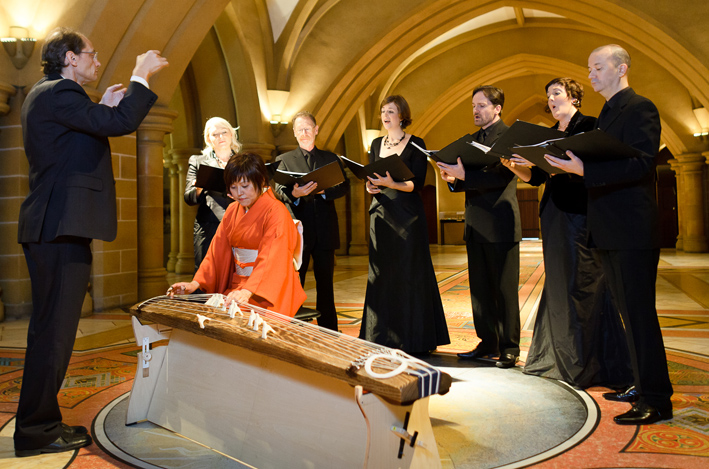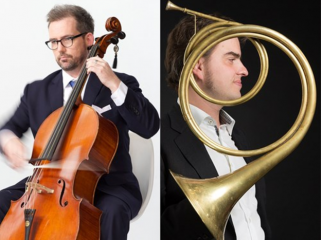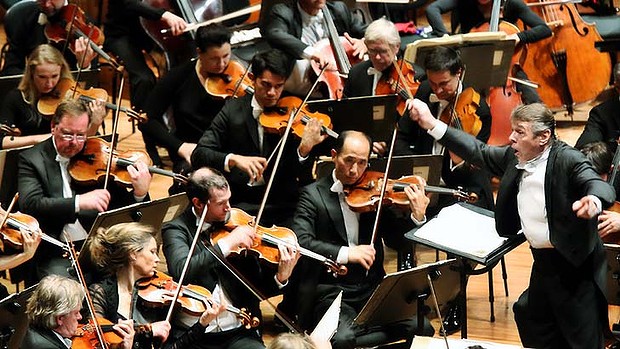Concert Review: Under Cover of Darkeness/ Castalia Vocal Consort
Under Cover of Darkness/ Castalia Vocal Consort
Glebe Town Hall
18 June 2022
Vocal consort Castalia, under the fine artistic direction of soprano Amy Moore, returned after their splendid premiere performance in February 2022 with an equally dazzling concert. This time the songs were all linked to the central theme of “nocturnal landscapes and wanderings.”
The previous ensemble of sopranos Chloe Lankshear and Amy Moore, mezzo-soprano Stephanie Dillon, tenors Christopher Watson and Louis Hurley and bass Philip Murray, was augmented to seven voices with bass Thomas Flint. This inclusion guaranteed an extra richness of lower sonority in the fully concerted works and a lively new presence in the group.
Fifteen vocal pieces spanning duets to 7-part madrigals and a work for voices altered with electronic effects made up this inventive programme. Juxtaposed with Renaissance English and Latin language works, was an impressive bracket of modern songs in Swedish featuring outstanding works by female composers. The concert was performed in a continuous flow with night-themed poems interspersed between sung items. A request for no applause between items allowed for an uninterrupted stream of consciousness exploring darkness and dreams.
The opening bracket of songs heralded twilight, both in a literal and metaphoric sense. The beautiful vaulted Victorian venue was lit by golden orbed floor lamps while the singers’ faces glowed from the stand lights. This left the audience in a half-light like the invoked evening and mirrored the affects created in the music.
Bookending the great English choral tradition were Britten’s Evening primrose (1950) and Wilbye’s Draw on sweet night (1598). These are works of subtle melancholy for the larger ensemble and were an ideal beginning for a journey into darkness and the unconscious.
A change of staging saw the lower voices move from the centre to stage right facing the female performers for Australian composer David Yardley’s Twilight on the snow. This was a surprising and refreshing work and it contrasted beautifully with the dense polyphony of Wilbye’s madrigal. Yardley draws on a lifetime love affair with the medieval world to evoke an ancient fantasy tableau of mysterious Druids in his work.
Also referencing medieval style was Robert White’s catholic prayer that would have been sung in secret during the protestant reign of Elizabeth I. The men chanted plainsong alternating with hushed 5-part chorales.
The central bracket moved the geography to Scandinavia and a contemporary musical palette. The even and pure non-vibrato approach to the early works relaxed to allow for warmth, richer chest tones and extended techniques from the singers. Folk music moved front and centre as a primary influence in works by Karin Rehnqvist, Eyvind Alnaes and Pelle Gundmundsen-Holmgren. Rehnqvist’s works were particularly impressive and interesting. In the second piece, When the night brings peace the Nordic technique of herding cows known as “kulning” became a dazzling opportunity for sopranos to show their coloratura agility and range over rapid arpeggios and leaps. The ensemble created a sonic bath of resonant overtones as a context for the bravura displays and the audience was magically transported to rural Nordic fjords.
Danish composer Gundmunsen-Holmgren extended the soundscape with wit and absurdist humour in his work based on Australian poet Les Murray’s Bats’ Ultrasound. Word painting the bat song “fine teeth bared to sing”- with whirring and whispering and a tour de force of finely tuned whistling this work was a highlight showcasing the incredible versatility and skills of Castalia’s singers. The complex rhythmic structures meant this was the only work that was conducted – and very ably by Chloe Lankshear as she also navigated the fiendish score vocally.
The longest work took a central place in the overall programme and saw the ensemble move to the far corner under a blue and green constellation of fairy lights where the sound system was pre-set ready for Kaija Saariaho’s Nuits, adieux. A more challenging contemporary sound world was employed with dual microphones for each of the four singers allowing for variations of reverberation electronically activated by vocal dynamics. This work fittingly created an image of the darkest abyss of night and was seamlessly assisted by the work of sound engineer Richard Hundy.
During the final works the lighting gradually dimmed as the floor lamps were shut off by the singers leaving only one central lamp at the finale. This layer of theatrical panache added greatly to the atmosphere. As the room darkened however, the downside was that the excellent programme notes and translations became ever more impossible to read, but this also took the audience further into a world of hearing and feeling and away from seeing and thinking.
The sensuality of Schutz’s sublime madrigal Ego dormio et cor meum vigilat provided the perfect vehicle to enter an erotically charged dreamscape. The rapid melismas in all four parts were executed with evident delight. After winning the trust of the audience with such beauty of harmony and counterpoint, Castalia boldly took them hurtling into the modern world with two duelling duets for female voices by Kaija Saariaho exploring the suicidal nightmares of Sylvia Plath. Gut wrenchingly desperate, these works are shocking in their unbridled anguish and were heartrendingly performed by Dillon, Lankshear and Moore.
As dawn finally broke in the metaphorical journey, Flint amusingly pondered the black hole of 4 am in his poetic offering and the entire ensemble returned to the English Golden Age of madrigals with Byrd’s magnificent Vigilate to conclude a sumptuous evening of music and poetry.
Immensely thoughtful programming from Amy Moore in this concert sets a high bar of excellence for Castalia and left the audience, finally released from their thrall to applaud, much anticipating what this consort have planned for future events.
Victoria Watson for SoundsLikeSydney©
A graduate of Melbourne University and VCA, Victoria appeared regularly as a soprano with the Victoria State Opera and has toured and served as artistic director of many chamber ensembles.
She has performed with Sydney Symphony Orchestra and for ten years, was artistic director of a major opera education project with Opera Australia. Since 2015 she has moved into directing opera including Mozart’s ‘Cosi Fan Tutte’ at the Independent theatre.
Victoria has lectured in voice at the major universities in Melbourne, and has tutored at UNSW. Having taught at major Sydney secondary colleges, she now runs a busy private singing studio. She is a published author on opera and a popular freelance music and theatre lecturer and advocate for Australian artists around the world.

